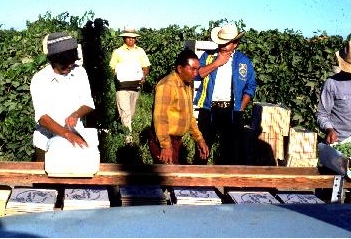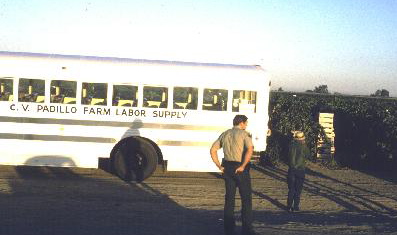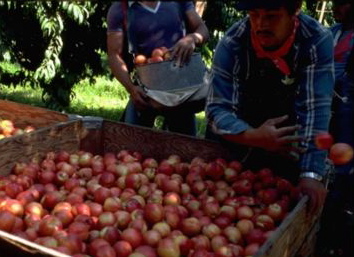
The Migrant and Seasonal Agricultural Worker Protection Act (MSPA) provides employment-related protections to migrant and seasonal agricultural workers. Every non-exempt farm labor contractor, agricultural employer, and agricultural association who "employs" workers must:
- Provide written disclosure of the terms and conditions of employment;
- Post information about worker protections at the worksite;
- Pay workers the wages owed when due and provide an itemized statement of earnings and deductions;
- Comply with the terms of any working arrangement made with the workers and,
- Make and keep for three years payroll records for each employee.
The protections do not apply to individuals who are independent contractors rather than employees. Agricultural workers can have more than one employer at the same time. Each "joint employer" is responsible for all employer obligations under the MSPA, but MSPA does not require the unnecessary duplication of effort. Thus, employer responsibility(ies) may be carried out by only one of the joint employers. However, the failure to provide the required protections will result in joint liability for all joint employers.
Below are answers to frequently asked questions concerning independent contractors and joint employers under MSPA. Further guidance can be obtained by contacting your nearest Wage and Hour office.
How does the MSPA law define the terms "independent contractor" and "joint employment"?
The law has borrowed these terms from the Fair Labor Standards Act (FLSA), where they were developed by the courts under the very broad definition of "employ" ("to suffer or permit to work"). The concept of joint employment is included within the "employment" relationship, but the status of independent contractor is not considered to be "employment."
What does the term "independent contractor" mean and how does it relate to MSPA?
An independent contractor is an individual who performs services but is not an employee of the person utilizing the services. Independent contractors are not covered by MSPA protections that apply to employees.
How does one determine if an individual is an "independent contractor" in the agricultural context?

This is done by examining whether the individual (who may be either a farm labor contractor or a worker) is economically dependent upon the person who utilizes his/her services. If the individual is economically dependent upon that person then that individual is an employee.
Simply being licensed as a farm labor contractor does not in itself make the FLC and independent contractor. He/She may be an employee of the person utilizing his/her services. If the farm labor contractor is an employee of the person utilizing his/her services, then the workers in the crew are also employees of that person. The determination of independent contractor status is based on all of the circumstances, including the following:
- The nature and degree of the alleged employer's control as to the manner in which the work is performed;
- The alleged employee's opportunity for profit or loss depending upon his/her managerial skill;
- The alleged employee's investment in equipment or materials required for the task, or the alleged employee's employment of other workers;
- Whether the services rendered by the alleged employee require special skill;
- The degree of permanency and duration of the working relationship;
- The extent to which the services rendered by the alleged employee are in integral part of the alleged employer's business.
What does the term "joint employment" mean and how does it relate to MSPA?
Joint employment means than an individual is employed by two or more persons at the same time. Where a joint employment relationship exists, each of the employers must ensure that the employee receives all employment-related rights granted by MSPA, such as accurate and timely disclosure of the terms and conditions of employment, written payroll records, and payment of wages when due.
How can one determine if "joint employment" exists?

This is done by examining all the facts in a particular case and examining the realities of the economic relationships between the workers and the alleged employers. The ultimate question is whether the agricultural work is economically dependent upon more than one person. Depending on the facts in each case, the joint employers could be any combination of the grower, the processor, the association, and the FLC (provided he/she is an independent contractor). Joint employment is not presumed to exist in agriculture, and no one fact or set of facts will necessarily result in a joint employment determination. In making the determination, the following facts must be considered:
- Whether the agricultural employer/association has the power, either alone or through control of the farm labor contractor to direct, control, or supervise the worker(s) or the work performed (such control may be either direct or indirect, taking into account the nature of the work performed and a reasonable degree of contract performance oversight and coordination with third parties);
- Whether the agricultural employer/association has the power, either alone or in addition to another employer, directly or indirectly, to hire or fire, modify the employment conditions, or determine the pay rates or the worker(s);
- The degree of permanency and duration of the relationship of the parties, in the context of the agricultural activity at issue;
- The extent to which the services rendered by the worker(s) are repetitive, rote tasks requiring skills which are acquired with relatively little training;
- Whether the activities performed by the worker(s) are an integral part of the overall business operation of the agricultural employer/association;
- Whether the agricultural employer/association's premises, rather than on premises owned or controlled by another business entity, and
- Whether the agricultural employer/association undertakes responsibilities in relation to the worker(s) which are commonly performed by employer, such as preparing and/or making payroll records, preparing and/or issuing pay checks, paying FICA taxes, providing workers' compensation insurance, providing field sanitation facilities, housing or transportation, or providing tools and equipment or materials required for the job (taking into account the amount of the investment.)
How is the test for joint employment in the revised regulation (effective April 12, 1997) different from the test in the original MSPA regulation?
The revised regulation does not change the substance of the joint employment test, but states the test more clearly and completely than the previous regulation. The revised regulation concisely states the required analysis ("economic dependence") and sets out the various analytical factors established by the courts--including the factors in the previous regulation, restated for clarity.
Without imposing any new legal standards, the regulation enables the Department of Labor, the courts, and the parties (workers, farm labor contractors, agricultural employers, and agricultural associations) to apply the MSPA joint employment concept more easily, accurately and consistently.
Does joint employment affect MSPA housing or transportation responsibility?
No. The MSPA does not impose responsibility for housing and transportation standards on an employer. A person is responsible for MSPA-covered housing only if that person "owns or controls" the housing occupied by a migrant agricultural worker. A person is responsible for transportation requirements only if the person is "using or causing to be used" any vehicle for providing transportation. The fact that a person may be an agricultural employer or a joint employer does not necessarily mean the employer is also responsible for complying with MSPA housing an/or transportation requirements.
 Print
Print Email
Email







